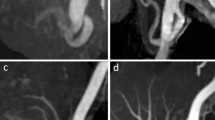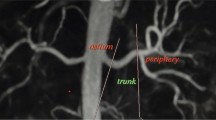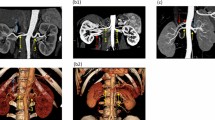Abstract
Purpose
To evaluate image quality of non-contrast-enhanced magnetic resonance angiography (MRA) and compare transplant renal artery stenosis (TRAS) seen by non-contrast-enhanced MRA with digital subtraction angiography (DSA) as the gold standard.
Materials and methods
330 patients receiving 369 non-contrast-enhanced MRA examinations from July 2014 to June 2017 were included. Thirty patients received at least two MRA examinations. Image quality was independently assessed by two radiologists. Inter-observer agreement was analyzed. Transplant renal artery anatomy and complications were evaluated and compared with DSA. If possible, accuracy was calculated on a per-artery basis.
Results
Good or excellent image quality was found in 95.4 % (352/369) of examinations with good inter-observer agreement (K=0.760). Twenty-two patients with DSA had 28 non-contrast-enhanced MRA examinations within a 2-month period. Of these, 19 patients had TRAS, two patients had pseudoaneurysms, and one patient had a normal transplant renal artery but an occluded external iliac artery. Non-contrast-enhanced MRA correctly detected 19 TRAS and nine normal arteries, giving 96.6 % accuracy on a per-artery basis.
Conclusions
Non-contrast-enhanced MRA demonstrates a good depiction of the transplanted renal artery and shows good correlation with DSA in cases where there was TRAS.
Key Points
• Good or excellent image quality was found in 95.4 % of examinations.
• Non-contrast-enhanced MRA can clearly map transplant renal artery anatomy.
• Non-contrast-enhanced MRA is a reliable tool to detect TRAS.






Similar content being viewed by others
Abbreviations
- CKD:
-
Chronic kidney disease
- CTA:
-
CT angiography
- DSA:
-
Digital subtraction angiography
- IFIR:
-
Inflow inversion recovery
- MRA:
-
Magnetic resonance angiography
- SSFP:
-
Steady-state free precession
- TRAS:
-
Transplant renal artery stenosis
References
Bugnicourt JM, Godefroy O, Chillon JM, Choukroun G, Massy ZA (2013) Cognitive disorders and dementia in CKD: the neglected kidney brain axis. J Am Soc Nephrol 24:353–363
Liu ZH (2013) Nephrology in China. Nat Rev Nephrol 9(9):523–528
Hart A, Smith JM, Skeans MA et al (2017) OPTN/SRTR 2015 Annual Data Report: Kidney. Am J Transplant 17:21–116
Jensen CE, Sørensen P, Petersen KD (2014) In Denmark kidney transplantation is more cost-effective than dialysis. Dan Med J 61:A4796
Cavallo MC, Sepe V, Conte F et al (2014) Cost-effectiveness of kidney transplantation from DCD in Italy. Transplant Proc 46:3289–3296
Zhang LJ, Wen J, Liang X et al (2016) Brain default mode network changes after renal transplantation: A diffusion-tensor imaging and resting-state functional MR imaging study. Radiology 278:485–495
Tang H, Wang Z, Wang L et al (2014) Depiction of transplant renal vascular anatomy and complications: unenhanced MR angiography by using spatial labeling with multiple inversion pulses. Radiology 271:879–887
Bruno S, Remuzzi G, Ruggenenti P (2004) Transplant renal artery stenosis. J Am Soc Nephrol 15:134–141
Pan FS, Liu M, Luo J et al (2017) Transplant renal artery stenosis: Evaluation with contrast-enhanced ultrasound. Eur J Radiol 90:42–49
Granata A, Clementi S, Londrino F et al (2014) Renal transplant vascular complications: the role of Doppler ultrasound. J Ultrasound 18:101–107
Ngo AT, Markar SR, De Lijster MS, Duncan N, Taube D, Hamady MS (2015) A systematic review of outcomes following percutaneous transluminal angioplasty and stenting in the treatment of transplant renal artery stenosis. Cardiovasc Intervent Radiol 38:1573–1588
Fananapazir G, McGahan JP, Corwin MT et al (2017) Screening for transplant renal artery stenosis: Ultrasound-based stenosis probability stratification. AJR Am J Roentgenol 209:1064–1073
Fananapazir G, Bashir MR, Corwin MT, Lamba R, Vu CT, Troppmann C (2017) Comparison of ferumoxytol-enhanced MRA with conventional angiography for assessment of severity of transplant renal artery stenosis. J Magn Reson Imaging 45:779–785
Corwin MT, Fananapazir G, Chaudhari AJ (2016) MR angiography of renal transplant vasculature with Ferumoxytol: Comparison of high-resolution steady-state and first-pass acquisitions. Acad Radiol 23:368–373
Blankholm AD, Pedersen BG, Østrat EØ et al (2015) Noncontrast-enhanced magnetic resonance versus computed tomography angiography in preoperative evaluation of potential living renal donors. Acad Radiol 22:1368–1375
Gaddikeri S, Mitsumori L, Vaidya S, Hippe DS, Bhargava P, Dighe MK (2014) Comparing the diagnostic accuracy of contrast-enhanced computed tomographic angiography and gadolinium-enhanced magnetic resonance angiography for the assessment of hemodynamically significant transplant renal artery stenosis. Curr Probl Diagn Radiol 43:162–168
Ismaeel MM, Abdel-Hamid A (2011) Role of high resolution contrast-enhanced magnetic resonance angiography (HR CeMRA) in management of arterial complications of the renal transplant. Eur J Radiol 79:e122–e127
Gufler H, Weimer W, Neu K, Wagner S, Rau WS (2009) Contrast enhanced MR angiography with parallel imaging in the early period after renal transplantation. J Magn Reson Imaging 29:909–916
Sun IO, Hong YA, Kim HG et al (2012) Clinical usefulness of 3-dimensional computerized tomographic renal angiography to detect transplant renal artery stenosis. Transplant Proc 44:691–693
Moreno CC, Mittal PK, Ghonge NP, Bhargava P, Heller MT (2016) Imaging complications of renal transplantation. Radiol Clin N Am 54:235–249
Fananapazir G, Troppmann C, Corwin MT, Nikpour AM, Naderi S, Lamba R (2016) Incidences of acute kidney injury, dialysis, and graft loss following intravenous administration of low-osmolality iodinated contrast in patients with kidney transplants. Abdom Radiol (NY) 41:2182–2186
Thomsen HS, Morcos SK, Almén T et al (2013) Nephrogenic systemic fibrosis and gadolinium-based contrast media: updated ESUR Contrast Medium Safety Committee guidelines. Eur Radiol 23:307–318
Dekkers IA, Roos R, van der Molen AJ (2017) Gadolinium retention after administration of contrast agents based on linear chelators and the recommendations of the European Medicines Agency. Eur Radiol. https://doi.org/10.1007/s00330-017-5065-8
Bultman EM, Klaers J, Johnson KM et al (2014) Non-contrast-enhanced 3D SSFP MRA of the renal allograft vasculature: a comparison between radial linear combination and Cartesian inflow-weighted acquisitions. Magn Reson Imaging 32:190–195
Lanzman RS, Voiculescu A, Walther C et al (2009) ECG-gated nonenhanced 3D steady-state free precession MR angiography in assessment of transplant renal arteries: comparison with DSA. Radiology 252:914–921
Liu X, Berg N, Sheehan J et al (2009) Renal transplant: nonenhanced renal MR angiography with magnetization-prepared steady-state free precession. Radiology 251:535–542
Fan WJ, Ren T, Li Q et al (2016) Assessment of renal allograft function early after transplantation with isotropic resolution diffusion tensor imaging. Eur Radiol 26:567–575
Bley TA, François CJ, Schiebler ML et al (2016) Non-contrast-enhanced MRA of renal artery stenosis: validation against DSA in a porcine model. Eur Radiol 26:547–555
Morita S, Masukawa A, Suzuki K, Hirata M, Kojima S, Ueno E (2011) Unenhanced MR angiography: techniques and clinical applications in patients with chronic kidney disease. Radiographics 31:E13–E33
Funding
The authors state that this work has not received any funding.
Author information
Authors and Affiliations
Corresponding authors
Ethics declarations
Guarantor
The scientific guarantor of this publication is Long Jiang Zhang.
Conflict of interest
UJS is a consultant for and/or receives research support from Astellas, Bayer, General Electric, Guerbet and Siemens Healthineers. AVS received research support from Siemens Healthineers. All other authors of this manuscript declare no relationships with any companies whose products or services may be related to the subject matter of the article.
Statistics and biometry
No complex statistical methods were necessary for this paper.
Informed consent
Written informed consent was waived by the Institutional Review Board.
Ethical approval
Institutional Review Board approval was obtained.
Methodology
• retrospective
• observational
• performed at one institution
Rights and permissions
About this article
Cite this article
Zhang, L.J., Peng, J., Wen, J. et al. Non-contrast-enhanced magnetic resonance angiography: a reliable clinical tool for evaluating transplant renal artery stenosis. Eur Radiol 28, 4195–4204 (2018). https://doi.org/10.1007/s00330-018-5413-3
Received:
Revised:
Accepted:
Published:
Issue Date:
DOI: https://doi.org/10.1007/s00330-018-5413-3




